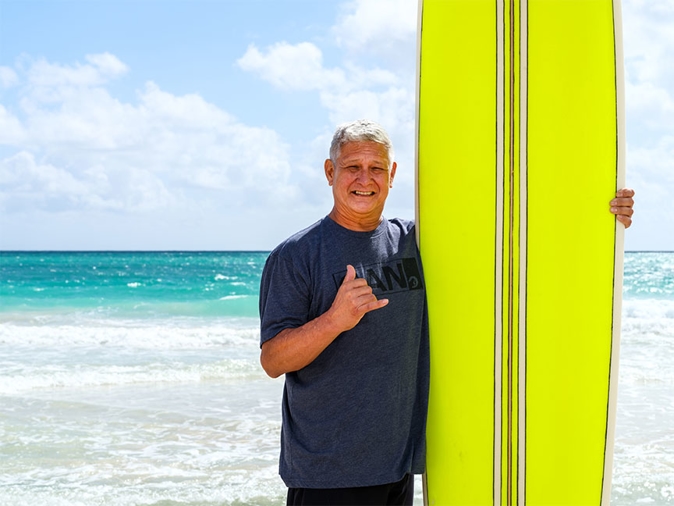
Back on the Surfboard After Open-Heart Surgery
David Yap’s love of surfing alerted him to a potentially deadly heart concern.
Surfing was David Yap’s life. The Kailua native, known to friends as Big Wave Dave, used to surf every day, well into his 60s. But when he moved home to O‘ahu after living on Hawai‘i Island for several years, he noticed that he was experiencing shortness of breath while surfing.
“I used to be able to paddle out 100 yards, no problem,” he says. “Suddenly, I lost my stamina. It got to the point where surfing was starting to become dangerous for me.”
His previous doctor had suggested that he might have asthma. But when Yap visited Nataliya Holmes, MD, a primary care provider at Adventist Health Castle Primary Care in Kailua, she had a feeling the issue was heart-related.
“He didn’t have any of the typical symptoms of asthma,” she says. “Instead, he was experiencing shortness of breath when he was exerting himself while surfing.”
Dr. Holmes ordered a full lab work-up to determine the cause of his health concerns and referred him to a cardiologist for specialized care. After doing several tests, Yap received unexpected news: He had a massive aneurysm in his heart.
A surprising discovery
Yap’s aorta — the largest blood vessel in the body — had an aneurysm, an abnormal bulge in the wall of the vessel. Aneurysms can grow over time and may rupture, which can cause internal bleeding, stroke or death.
Yap’s aneurysm was especially large, measuring 6.5 centimeters, roughly the size of an egg or a lemon. His high blood pressure increased the chances of the bulge rupturing.
“The doctor told me we needed to operate quickly,” Yap says. “I had a lot of anxiety leading up to surgery because I was worried that it could burst while I was driving or working.”
Luckily, Yap was able to schedule his operation quickly. Within a week of his diagnosis, he was having open-heart surgery at Adventist Health Castle.
Repairing the damage
Specially trained surgeons removed the damaged section of Yap’s aorta and replaced it with an artificial vessel. After three days in intensive care and two days in recovery, Yap went home to continue healing.
“I was sitting up, walking easier — I attribute that to my core strength from surfing,” Yap says. “I met another patient who had been in rehab for two months. Meanwhile, my operation was a month ago, and you almost wouldn’t know I just had open-heart surgery.”
A grateful heart
When Yap learned that he needed surgery for his aneurysm, some people told him to go to a hospital on the mainland, he says.
“I said, ‘No way, I’m staying close to home.’ I’m so glad I did,” Yap adds. “The quality of care was incredible. I can’t thank the entire staff enough.”
As for Dr. Holmes, who first encouraged him to investigate the source of his shortness of breath, Yap says he’s eternally grateful.
“I hugged her and said, ‘You saved my life,’” he says. “If it wasn’t for her telling me to do these tests, I probably wouldn’t have made it.”
Yap says he’s taking his recovery seriously because he wants to get back in the water and on the surfboards he shapes. “My breastplate is still healing, so I’m lying low, but I’m willing to give up four months of surfing if it means I get to live until I’m 100,” he says.
Read More: Better With Age: Four Tips to Stay on Top of Your Health
Preventing emergencies
When Yap felt that something wasn’t quite right, he went to his primary care provider for help. Dr. Holmes says that was the right step.
“David is a good example of why it’s important to go to your appointments even if you feel healthy,” she says. “We’re the first line of defense — we can do labs, talk about symptoms, and I can help outline the right steps to stay healthy.”
Preventative care involves staying ahead of potential health concerns and making positive lifestyle changes to reduce the likelihood of illness. This care may include:
- Screening for cancers
- Lab work to identify early signs of disease
- Lifestyle improvements that promote physical and mental well-being
- Prescribing medication
- Referrals to specialists who can provide in-depth care
Find a primary care provider near you to stay ahead of health emergencies.


